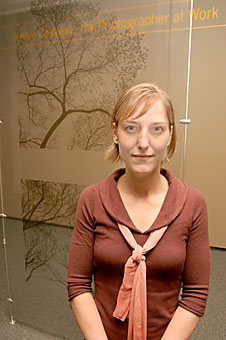 |
|
Cassie Tomlin/Arizona Daily Wildcat
|
Center for Creative Photography curator Britt Salvesen has worked on the center's latest show "Harry Callahan: The Photographer at Work" for the past year.
|
|
|
By Cassie Tomlin
Arizona Daily Wildcat
Thursday, February 2, 2006
Print this
A fitting tribute to a man whose work helped build the Center for Creative Photography is on display there now. "Harry Callahan: The Photographer at Work," a retrospective exhibition, opened Friday.
In establishing the museum in 1974, its founding fathers (including Ansel Adams and then-university President John Schaeffer) hoped to make it a place for housing entire archives instead of individual prints. Harry Callahan's photographic collection was one of five obtained in what has been called "the largest single acquisition in the history of photography." Today, the CCP houses more archives and singular works by 20th-century North American photographers than any other museum in the nation.
CCP curator Britt Salvesen spent the past year and a half sorting through thousands of Callahan's works to assemble a show depicting the photographer's process. Along with about 80 color and black-and-white prints exhibited are contact sheets, working prints, negatives and archiving lists Salvesen believes help explain Callahan's work as a whole.
Callahan was prolific (a CCP staff inventory revealed that he pressed the shutter over 140,000 times) and experimental (a photo from his 1940s series "Weeds and Snow" was so abstract that it was accidentally run upside down in the New York Times Magazine,) yet his self-described repertoire revolves simply around nature, buildings and people.
The show is mostly organized that way, each element belonging to one of the gallery's three areas.
In 1941, inspired by an Ansel Adams photography workshop, Callahan (1912 – 1999) abandoned his blue-collar career with Chrysler in Detroit and dedicated his life to photography.
Still, Salvesen emphasized his determination and work ethic.
"He did it because that's what he loved to do," Salvesen said. "It wasn't work to him. It was play, and it was his chosen path."
Although he had no formal training or background in photographic art, Callahan rose to great popularity in the 1940s and beyond. Maybe his most recognizable work is a 1949 image of his wife Eleanor emerging from the waters of Lake Michigan, which has many times served as the "teaser" image on show announcements and invitations (including this one at the CCP).
Callahan's most famed images are those of his wife, Eleanor, whom he used as a model for much of their lives together, Salvesen said.
A grouping of photos made from 8x10 inch negatives, 8x10 Snapshots, feature Eleanor and the Callahans' daughter, Barbara, posing against Chicago landscapes in the 1950s. The figures are tiny against skylines, oceans and fields, and were made to express, among many things, Callahan's interest in the relationship between the figure and nature.
These directionally composed pictures, dubbed "snapshots" for their seemingly typical form, are among Salvesen's favorites in the exhibition, she said.
"I find it exciting that he looked into his viewfinder and saw something unexpected," she said. "It was a totally new kind of picture he invented. There's an argument that a photographic artist can't make a snapshot because of their self-imposed practices or their formal training in composing. Their eyes aren't capable of producing a snapshot. Callahan was able to identify and exploit the characteristics with centrally posed, stiff figures, symmetrical framing and shadows."
As an artist, Callahan didn't speak much for his work, but let the work speak for itself.
"Did he understand or care what others saw in his work? Not really, but he was glad that it spoke to them. How did he change direction, get through dry spells? By photographing," Salvesen said.
"Harry Callahan: The Photographer at Work" is on display at the CCP until May 7. There you can also find Salvesen's book of the same name for sale.
